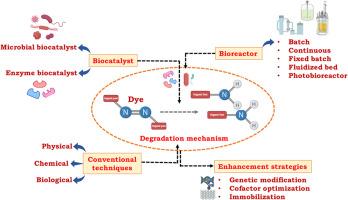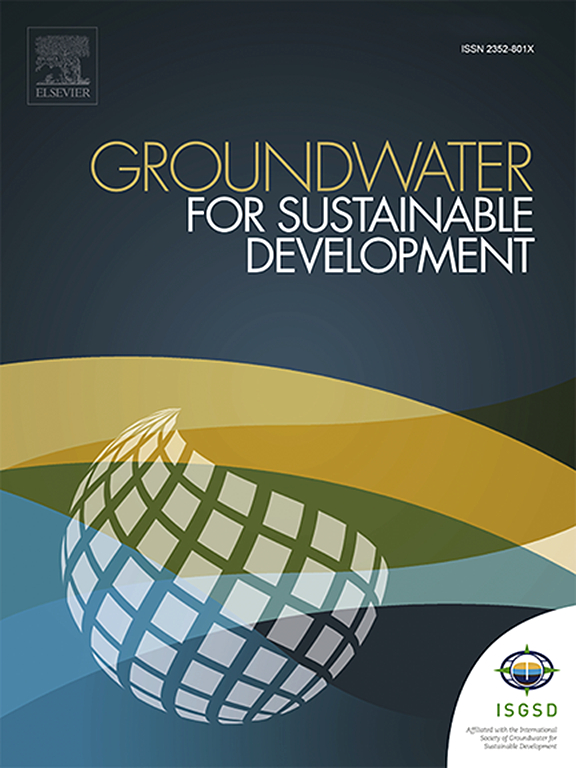Review on the mechanisms and emerging prospects of biocatalytic dye degradation: Reactor systems and optimization strategies
IF 4.9
Q2 ENGINEERING, ENVIRONMENTAL
引用次数: 0
Abstract
The widespread use of dyes has resulted in a concerning rise in the discharge of hazardous substances into the environment. The allergenic and carcinogenic properties of dyes pose significant risks to both human health and the environment. Various approaches are being used to address the mounting ecological issues associated with dye pollution. The process of degradation is tedious due to the persistent, recalcitrant, and non-degradable nature of dyes. Biocatalytic degradation represents a promising approach in addressing the environmental impacts caused by synthetic dyes. Biocatalytic techniques use enzymes and microorganisms to break down complex dye compounds. Certain processes, such as redox reactions aided by laccases, azo-reductases, and peroxidases, are involved in the degradation process. The performance and applicability of several bioreactor designs, including batch, continuous, and bed bioreactors, for dye degradation is reviewed. The effectiveness of the bio-catalytic degradation process has been addressed in relation to enhancement techniques including immobilization and genetic modification. The incorporation of cutting-edge technology holds considerable potential for the sustainable treatment of wastewater tainted with dyes, despite obstacles related to the economy and ecology.

回顾生物催化染料降解的机理和新兴前景:反应器系统和优化策略
染料的广泛使用导致有害物质排放到环境中的数量增加,令人担忧。染料的致敏和致癌特性对人类健康和环境都构成了重大风险。目前正在采用各种方法来解决与染料污染相关的日益严重的生态问题。由于染料的持久性、难降解性和不可降解性,降解过程十分繁琐。生物催化降解是解决合成染料造成的环境影响的一种很有前景的方法。生物催化技术利用酶和微生物来分解复杂的染料化合物。降解过程涉及某些过程,如氧化还原反应,由裂解酶、偶氮还原酶和过氧化物酶辅助。本文对用于染料降解的几种生物反应器设计(包括间歇式、连续式和床式生物反应器)的性能和适用性进行了综述。生物催化降解过程的有效性与固定化和基因修饰等增强技术有关。尽管存在经济和生态方面的障碍,但尖端技术的采用为可持续处理染料废水带来了巨大的潜力。
本文章由计算机程序翻译,如有差异,请以英文原文为准。
求助全文
约1分钟内获得全文
求助全文
来源期刊

Groundwater for Sustainable Development
Social Sciences-Geography, Planning and Development
CiteScore
11.50
自引率
10.20%
发文量
152
期刊介绍:
Groundwater for Sustainable Development is directed to different stakeholders and professionals, including government and non-governmental organizations, international funding agencies, universities, public water institutions, public health and other public/private sector professionals, and other relevant institutions. It is aimed at professionals, academics and students in the fields of disciplines such as: groundwater and its connection to surface hydrology and environment, soil sciences, engineering, ecology, microbiology, atmospheric sciences, analytical chemistry, hydro-engineering, water technology, environmental ethics, economics, public health, policy, as well as social sciences, legal disciplines, or any other area connected with water issues. The objectives of this journal are to facilitate: • The improvement of effective and sustainable management of water resources across the globe. • The improvement of human access to groundwater resources in adequate quantity and good quality. • The meeting of the increasing demand for drinking and irrigation water needed for food security to contribute to a social and economically sound human development. • The creation of a global inter- and multidisciplinary platform and forum to improve our understanding of groundwater resources and to advocate their effective and sustainable management and protection against contamination. • Interdisciplinary information exchange and to stimulate scientific research in the fields of groundwater related sciences and social and health sciences required to achieve the United Nations Millennium Development Goals for sustainable development.
 求助内容:
求助内容: 应助结果提醒方式:
应助结果提醒方式:


